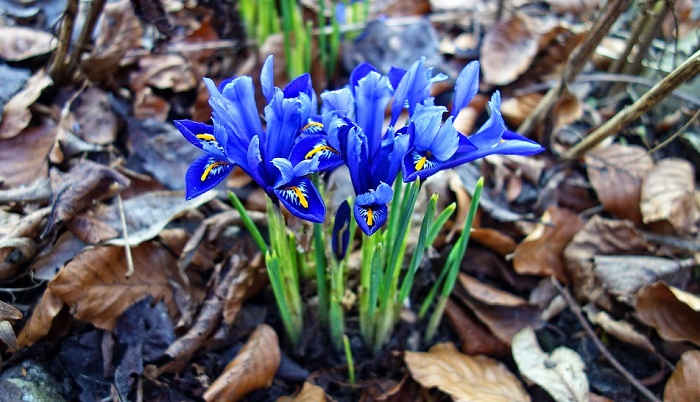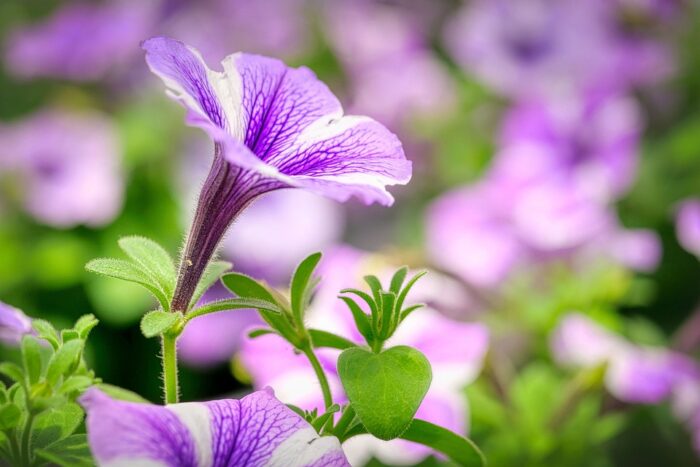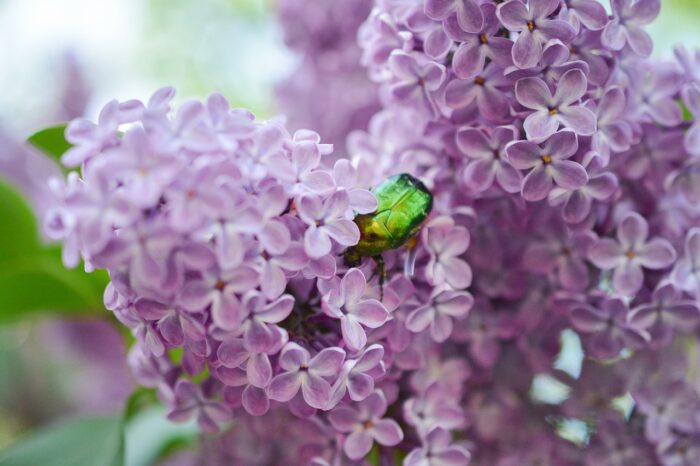Iris Flower – Meaning, Symbolism and Colors
Flower symbolism is full of interesting stories and myths we might have not even heard of. Something as simple as a field flower, can ide so much beauty and charm in its history that is almost incredible.
Flower symbolism has been alive for hundreds of years. People used flowers as not only decoration for special occasions but also as strong symbols of happiness, joy, love and care for other people. Sometimes flowers were hiding a more sinister and evil symbolism behind them, and these symbolic meanings managed to live on until today.
When we mention a flower like red rose, the instant reaction or thing we think about is love and romance. This flower is something that reminds us about Valentine’s Day and love we have inside for someone really special. It is always interesting to find out how flowers got the symbolisms they have and what actually inspired people to start this avalanche of symbolism for a particular flower.
In today’s text we will be talking about Iris flower and the secret symbolism and meaning behind it. This beautiful flower is a very common part of bouquets and flowers arrangements, but it is always fun to learn more about the secret symbolism hiding behind it. So, if you ever wanted to learn more about the Iris flower, here is a chance to do that.
Meaning of the Iris flower
Like I mentioned earlier, every flower has its own symbolic meaning and symbolism in general. The meaning behind a flower is something that has been created by people who spent their lives believing in stories surrounding certain flower sorts, because these flowers were so interesting and important to them.
Meaning of a particular flower can also be helpful when choosing a perfect flower for someone you love. We all know, when we want to impress that special person, we can’t just pick any flower.
So, the meanings behind the Iris flower are:
Faith
- Iris flower represents faith and hope for a better tomorrow. This beautiful flower was often gifted to the ones who needed additional support and love in tough moments. This gorgeous flower symbolized everything that is good in the world and everything we have yet to look forward to in the future.
Hope
- Similar to the above symbolism, the beautiful Iris flower also symbolized hope and belief that one day we will reach the happiness we are striving towards to. This flower was gifted to the ones who needed to be uplifted and reminded that there is a lot of good in this world, but we have to be persistent in finding it.

Wisdom
- Another meaning of the Iris flower is wisdom. This flower symbolized eternal knowledge and desire to always learn more and to have an inquisitive nature in life. The Iris flower can be a perfect gift for your friend or family member who needs support and love right now.
Royalty
- The Iris flower represents royalty and nobility. This flower was considered to be a symbol of kings and royal families for hundreds of years, which are why this meaning remained one of the first association’s people, have with the Iris flower.
Iris Flower – Etymological meaning
The Iris flower got its name after the Greek goddess Iris why was a messenger to the gods. This goddess, according to myths and legends, was able to use the rainbow to create a bridge between earth and the heaven. This ancient culture believed that Iris’s coat was actually a rainbow because it was multicolored and it resembled a rainbow.
The beautiful Iris flower also reminded the Greeks of the beloved goddess, so they got the name after her. Some even believed that these flowers represented flowing veils of her coat and robe. Iris flowers had the power to bring bliss and favor to earth and people living on it.
Iris Flower – Symbolism
Iris flower has a very rich symbolic meaning. These gorgeous flowers were planted on graves of women who had deceased, because ancient Greeks believed that these flowers will summon the goddess Iris and then she would lead the deceased women to heaven safely. Flower of Iris was beloved in another important ancient civilization and those were the Egyptians. They were most likely influenced by the ancient Greeks, because just like in Greece the Iris flower represented heaven in ancient Egypt as well.
In France, however, the Iris flower symbolized royalty and was often a symbol of power as well. National symbol of France is fleur-de-lis, and this important symbol was very much influenced by the Iris flower. In United States, the Iris flower is the birth flower of month of February and also a gift for the 25th wedding anniversary. State Tennessee proudly presents the Iris flower as its state flower.
Iris Flower – Color meaning
Color of a flower has a significant meaning and can sometimes add a lot to the overall symbolism of a flower. Some flowers come in various shades and shade ranges, while others only have one color to flaunt around with. The Iris flower comes in several different colors and every color has a special symbolic meaning and significance.
These colors are:
Purple
- Color purple is a symbol of royalty and nobility. This beautiful flower can also be a symbol of beauty and respect. Giving someone this flower means you respect this person and you are willing to show that person respect in every way possible. There is nothing that can express respect and admiration you feel towards someone, than with this gorgeous flower. Purple can also be a little bit of an extravagant color, so make sure you choose the right person to give this flower to.
Yellow
- Yellow symbolizes passion and friendship. This flower color is going to be a perfect gift for someone who is your loyal friend or family member. The yellow Iris flower sends a strong message to the other person, but it can also be a perfect statement piece in your home where it can attract positive energy into your home.
White
- White Iris flower is simply beautiful and so gentle looking. This flower is sending other a message of innocence and purity. White Iris flowers are usually used for decoration on weddings and baptisms.
Blue
- Color blue is a symbol of faith and hope. Together with the symbolic meaning of the Iris flower, this color perfectly complements the symbolism and it represents a perfect gift for everyone who needs a little bit of support and help in achieving the desired goals.
Iris flower – Botanical facts and characteristics
Today, the Iris is grown in gardens as an ornamental plant, and is grown on larger areas for the production of Iris flowers. It is widespread in the Mediterranean, and is mostly cultivated in France, Italy, Morocco and part of Central Europe.
Iris is a perennial herbaceous plant of strong, branched and thickened rhizome. The stem is straight and branched, up to 100 cm high. The leaves are flat, gray-green. The length of the leaves is up to 70 cm, and the width is over 5 cm. The leaves are arranged alternately in two rows. The flowers are large, blue or blue-violet colors and have a pleasant smell. Plants bloom during May and June.
The fruit is in the form of a capsule made up of several parts and shoots longitudinally. Seeds are elongated, cylindrical shape. Overground parts fall through winter. Roots lie horizontally or sloped in the ground and withstand low temperatures without damage. New overground organs are being developed during next spring. Although Irises are developing shallow under the surface, plants tolerate summer heat and drought very well.
It uses scrubs in a dry state from the perennial plant. It produces a powder that is used in the manufacture of toothpaste, powders and other cosmetic products. Iris is used in folk medicine as a coughing agent and as a diuretic. In some places, they are dried and mixed with rice, and given children to chew on it when their teeth grow.
A fresh Iris has an unpleasant smell, unlike a dried and odorless, smelli of violet. The Iris contains about 50% starch and 0.1-0.2% essential oil in which the main ingredients. The myristic acid (85%) and iron give the oil a purple scent. In addition, Iris is used in the making of some liqueurs and bitter brandy. The oil is crude at room temperature and is used for the production of fragrances (perfumes).
Iris is successful in all parts of the Mediterranean. The underground tree tolerates low temperatures very well and it prunes without damage. During the spring it requires more heat and light. By increasing the temperature and decreasing humidity, plants reduce their growth activity. For the cultivation of Iris, loose, sandy and dry soils are suitable. It works well on the rocky and sun exposed place.
Iris flowers as a two-year-old plant, rarely as a three-year culture and should be planted behind cultures that do not leave weeds. These are mainly fertilized with foliage, but sugars are also suitable. After the second year, that is, after the removal of Irises, the root is a suitable pre-culture for many species, since it also releases the soil early.
Basic soil treatment should be done as for all other cultivated crops. For planting in autumn, plowing should be done at full depth, immediately after removing the previous crop. Pre-sow soil preparation should also be done immediately. In the case of spring planting, the fed surface is left until winter.
Intake of nutrients is necessary if the Iris is grown on skeletal (rocky) and poor soil. All types of fertilizers are recommended for the basic treatment, and the quantities depend on the fertility of the soil. In pre-earth soil preparation, mineral NPK fertilizers with increased potassium content in the amount of 400 to 600 kg / ha are used.
Usually, Irises exclusively reproduce vegetatively. When planting, smaller Irises are not suitable for drying, as well as peaks of larger Iris, and parts of large Iris can also be used. Planting is done in early autumn, ie at the time of the removal of Iris.
The Iris shuld be planted into rows at a distance of 50 – 70 cm and about 25-30 cm between the plants. Can also be planted with potato planters. On smaller scales, planting is carried out manually so that seedlings are laid in the depths of 8-10 cm and then filled with soil. For 1 ha it is necessary to plant at a distance of 50 x 25 cm 80 000 plants, and at a distance of 70 x 30 cm, 47 600 plants.
During the vegetation, the plant roots should be dug and stored. A specific measure of care needs to be applied to the Iris flowers.
Watering should be done two to three times weekly, depending on the degree of soil compactness and accuracy. The most frequent is mediterranean cultivation, whereby care should be taken not to damage Irises that grow horizontally, just below the surface of the soil. If during the vegetation, Irises climb of the fence, they should be wrapped around the ground. This is accomplished by adjusting the cultivator to get the ground on the Iris from the interconnected area.
Irises are fed with nitrogen fertilizer (KAN) in the amount of 100 – 200 kg / ha, most often during vegtation, at the same time with intercropping. In the later years, 200-250 kg / ha of fertilizer is applied in the early spring before vegetation.
Removal of rhizomes is done when the plantation is two or three years old. The rice is removed after the blooming, i.e. at the end of summer and early autumn. Undergo a shake-up or using root crop machinery. The harvest can be done in the early spring, before the beginning of vegetation. The Iris es are cleaned after the harvest from the veins and parts from which the above-ground part is developed, then they are washed and calibrated. Small Irises and parts of large Irises are used to restore the plantations. Washed Irises are scrubbed, cut lengthwise and then left in water to preserve a beautiful natural color.
The fresh Iris quickly dies in direct sunlight or in drying places at temperatures up to 50 ° C. Dried Irises smell sweetly like violets. For 1 kg of dried Iris, about 4 kg of fresh Iris is needed.
The dry product is packaged in 25 kg sack bags or paper multi-layered sacks and stored in a dry and dark place. Particular attention should be paid to insect protection for storage. Dried down Irises are hard and tough, white or light yellow in color and have a pleasant smell of violet, which eventually becomes more intense.
The Irises used for the production of essential oils after harvesting are cleared of above-ground parts, veins and possible damage, then washed and droughted out. The dried product is stored and kept for a full year and then distilled.
Iris Flower – Secret message
People used flowers as not only decoration for special occasions but also as strong symbols of happiness, joy, love and care for other people. Flowers have a strong symbolical meaning and they weren’t only used by people when they wanted to give someone a gift, they were also strong symbols used by poets and artists. Sometimes flowers were hiding a more sinister and evil symbolism behind them, and these symbolic meanings managed to live on until today.
The Iris flower is also sending you an important message, you need to understand and implement in your life. The Iris flower is telling you to always respect others and to always show them how much they mean to you. Flower symbolism is there to help you find a perfect gift for the person you love and a perfect flower that will express your deepest emotions.

